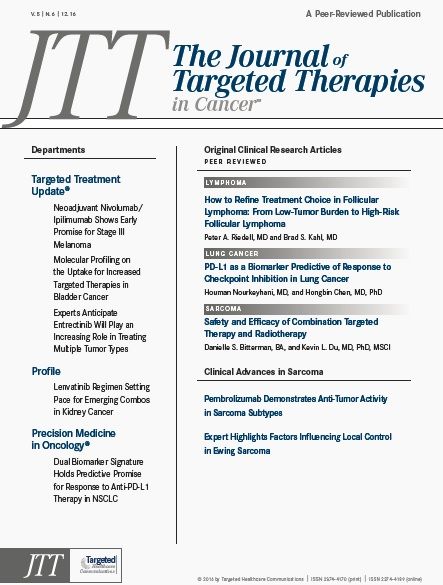Neoadjuvant Nivolumab/Ipilimumab Shows Early Promise for Stage III Melanoma
Neoadjuvant therapy with the combination of nivolumab and ipilimumab is plausible and effective, but can induce a high level of adverse events calling for further research into better tolerated dosing schemes.
Christian U. Blank, MD
Neoadjuvant therapy with the combination of nivolumab (Opdivo) and ipilimumab (Yervoy) is plausible and effective, but can induce a high level of adverse events (AEs) calling for further research into better tolerated dosing schemes, according to findings from the OpACIN trial1presented at the 2016 Society for Melanoma Research Annual Meeting.
“Ipilimumab plus nivolumab in the neoadjuvant setting is feasible, and all patients underwent a lymph node dissection on time,” said lead investigator Christian U. Blank, MD, a medical oncologist at The Netherlands Cancer Institute, Amsterdam, Netherlands. “However, we saw a high percentage of grade 3/4 toxicities, resulting in only 2 of the 18 patients receiving the full courses of ipilimumab plus nivolumab.”
In the phase Ib study, 20 patients were treated with nivolumab plus ipilimumab before or after surgery for stage III palpable melanoma with no in-transit metastases in the last 6 months. Across both arms, ipilimumab was administered at 3 mg/kg and nivolumab was given at 1 mg/kg every 3 weeks. In the neoadjuvant arm, patients received 2 cycles of therapy prior to surgery followed by 2 cycles of the combination after resection. In the adjuvant arm, 4 cycles of nivolumab and ipilimumab were administered following resection.
At the time of the September 2016 data cutoff, 8 patients in the adjuvant arm and 10 in the neoadjuvant arm were assessable. The mean age of patients in the adjuvant group was 53 ±7 years. In the neoadjuvant group, the mean age was 55 ±12 years. Seven patients in each arm had stage IIIb disease and the remainder had stage IIIc melanoma. All patients had normal LDH and ALC levels and all patients had a WHO performance status of 0.
The overall response rate in the neoadjuvant setting was 80%, which included 3 patients (30%) who experienced a pathologic complete response (pCR). Six patients (60%) had detectable micrometastatic disease following resection, of which 4 were labeled as near pCRs, said Blank. Two patients (20%) had disease detected in the lymph nodes.
“So far we have only the CR rates, so we still have to wait to see whether these patients with CRs and near CRs will relapse,” said Blank. “If this holds true, from what we know about immunotherapy, this could become a really interesting treatment options.”
Overall, 2 patients had relapsed, 1 had received only 2 courses of treatment due to grade 3 colitis and the other had only received 1 course as a result of grade 3 dermatitis.
In the adjuvant arm, 3 patients had relapsed at the time of the analysis. One of these patients had received 3 courses of treatment and stopped due to colitis. The remaining 2 patients had received just 2 courses of therapy following the development of hypophysitis and colitis, respectively.
A difference in surgery-related AEs was not observed between the 2 arms, suggesting that neoadjuvant ipilimumab plus nivolumab did not complicate resection. Overall, however, only 2 of the 18 evaluable patients completed 4 courses of therapy, with the majority stopping as a result of grade 3/4 AEs.
Across the full study, the most common all-grade AEs were elevated ALT (n = 15), diarrhea (n = 11), elevated lipase (n = 10), rash (n = 9), fatigue (n = 9), nausea (n = 9), colitis (n = 7), hypothyroidism (n = 7), hyperthyroidism (n = 6), vomiting (n = 6), and headache (n = 6). The most common grade 3/4 AEs were elevated lipase (n = 7), colitis (n = 6), diarrhea (n = 6), and elevated ALT (n = 4).
The rate of AEs seen in the study was above expectations, based on data from trials conducted in the metastatic setting. This could be related to systemic immune suppression in later stage melanoma. In the phase III EORTC 18071 trial, which explored adjuvant ipilimumab at 10 mg/kg for patients with advanced melanoma, the rate of grade 3/4 AEs was higher in those with stage III disease (45.4%) versus those with stage IV melanoma (34%).2
“With the higher stages, the possibility to restimulate the T cells drops dramatically,” said Blank. “There have been hints from different trials that the higher the stage gets the more systemic immune suppression there is.”
Ongoing studies are exploring whether this toxicity can be ameliorated while preserving ef cacy through various dosing strategies. To this end, the phase II OpACIN-Neo trial will assess 3 treatment schedules prior to surgery. This study is expected to open in the next 2 weeks, according to Blank.
In the first arm of the study, which will enroll patients with stage III measurable melanoma, patients will receive two 3-week cycles of ipilimumab at 3 mg/kg with nivolumab at 1 mg/kg. In the second group, two 3-week cycles of ipilimumab will be given at 1 mg/kg with nivolumab at 3 mg/kg. A sequential approach will be examined in the third arm, with ipilimumab at 3 mg/kg given for 2 cycles followed by 2 cycles of nivolumab at 3 mg/kg.
References:
- BlankCU,vanAkkooiA,RozemanL,etal.(Neo-)adjuvantipilimumab+nivolumab (IPI+NIVO) in palpable stage 3 melanoma the OpACIN trial. Presented at: Society for Melanoma Research Annual Meeting; Boston, Massachusetts, November 6-9, 2016.
- Eggermont AM,Chiarion-Sileni V, Grob JJ, et al. Adjuvant ipilimumab versus placebo after complete resection of high-risk stage III melanoma (EORTC 18071): a ran- domised, double-blind, phase 3 trial. Lancet Oncol. 2015;16(5):522-530. doi: 10.1016/ S1470-2045(15)70122-1.

Survivorship Care Promotes Evidence-Based Approaches for Quality of Life and Beyond
March 21st 2025Frank J. Penedo, PhD, explains the challenges of survivorship care for patients with cancer and how he implements programs to support patients’ emotional, physical, and practical needs.
Read More